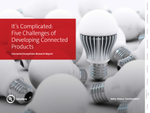
Connected Ecosystems Research Report e-book (English)
Understand and solve real-word connected product development challenges.

The Internet of Things (IoT) provides vast possibilities for product development and innovation. From smartwatches to connected appliances, IoT automation impacts us all.
Although analysts predicted that the IoT market would surge quickly, studies have found that growth is slower than anticipated. Manufacturers face some key challenges when developing connected products.
Each year, the number of IoT devices expands, yet many consumers are concerned about potentially fatal ramifications of IoT devices in the real world. Consumers want products that works seamlessly as intended.
According to a 2018 Dynatrace Consumer Confidence Report, 83% of consumers worry about losing control of their smart home due to performance problems. That same source reports that 62% of consumers worry that connectivity issues will increase as IoT becomes more prevalent.
So why do IoT device features fail in real-world settings? Here are some key challenges that manufacturers must keep in mind as they create connected devices:
Not addressing the challenges listed above can negatively affect brand reputation and, in severe situations, harm the user.
In addition to building consumer trust, brands also have increased responsibility regarding regulatory compliance. As safety regulations and requirements can differ from country to country, it’s always advisable to learn about market-specific regulations.
As more people adopt IoT devices, implementing strategies, best practices and controls that can protect the devices’ safety , functionality and security becomes increasingly important.
At UL Solutions, we can help assess whether your products operate seamlessly with other devices and major connectivity/IoT platforms and standards. This can help you deliver reliable, safer and more secure connected products to consumers, improving your customers’ experience and your brand reputation.
Access our e-book to learn more about overcoming the challenges of developing connected products.

Connected Ecosystems Research Report e-book (English)
Gain confidence in your connected product's ability to perform correctly and securely with a wide range of devices.